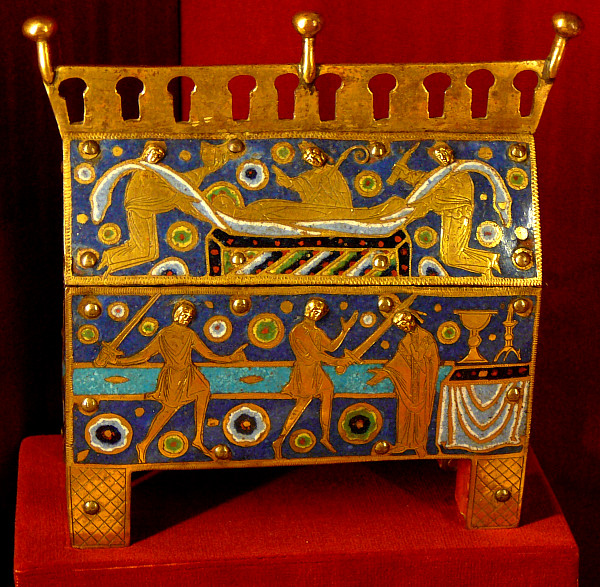Chasse with the Martyrdom of Thomas à Beckett

Limoges, France, circa 1190-1200
Copper champlevé enameled and gilded
Musée National de l'Age Médiévale, Paris
In the lower scene two of Henry II's knights step forward to assassinate St. Thomas à Beckett while he is saying Mass in Canterbury Cathedral.
In the scene above, a bishop (with mitre and crozier) directs two figures who are bearing the saint's body on a long sheet. One would think that this is a scene of the interment of the saint, and that is what it must be if the dating is correct. But if it were possible to date the chasse as late as 1220 another more attractive possibility would open up: that the scene is the
translation
the moving of a saint's body or partial relics to what is considered a more appropriate location
of the saint's relics, an event that was celebrated with great pomp in 1220, when the relics were moved to a more sumptuous setting in the cathedral under the direction of Archbishop Stephen Langton.
This interpretation would explain why there is a bishop in the scene. The Golden Legend stresses repeatedly that the other English bishops stood with the Henry II in his dispute with Beckett, so it would be strange that one of them figure so prominently in an interment scene.
Furthermore, the translation itself was considered a major event in English history. It had its own section in Caxton's version of the Legend, and its date was celebrated as the saint's primary feast.
Finally, it would make sense that a reliquary such as this chasse would feature the translation of the saint's relics.
Read more about images of St. Thomas à Beckett.
Photographed at the site by Richard Stracke, shared under Attribution-NonCommercial-ShareAlike license.